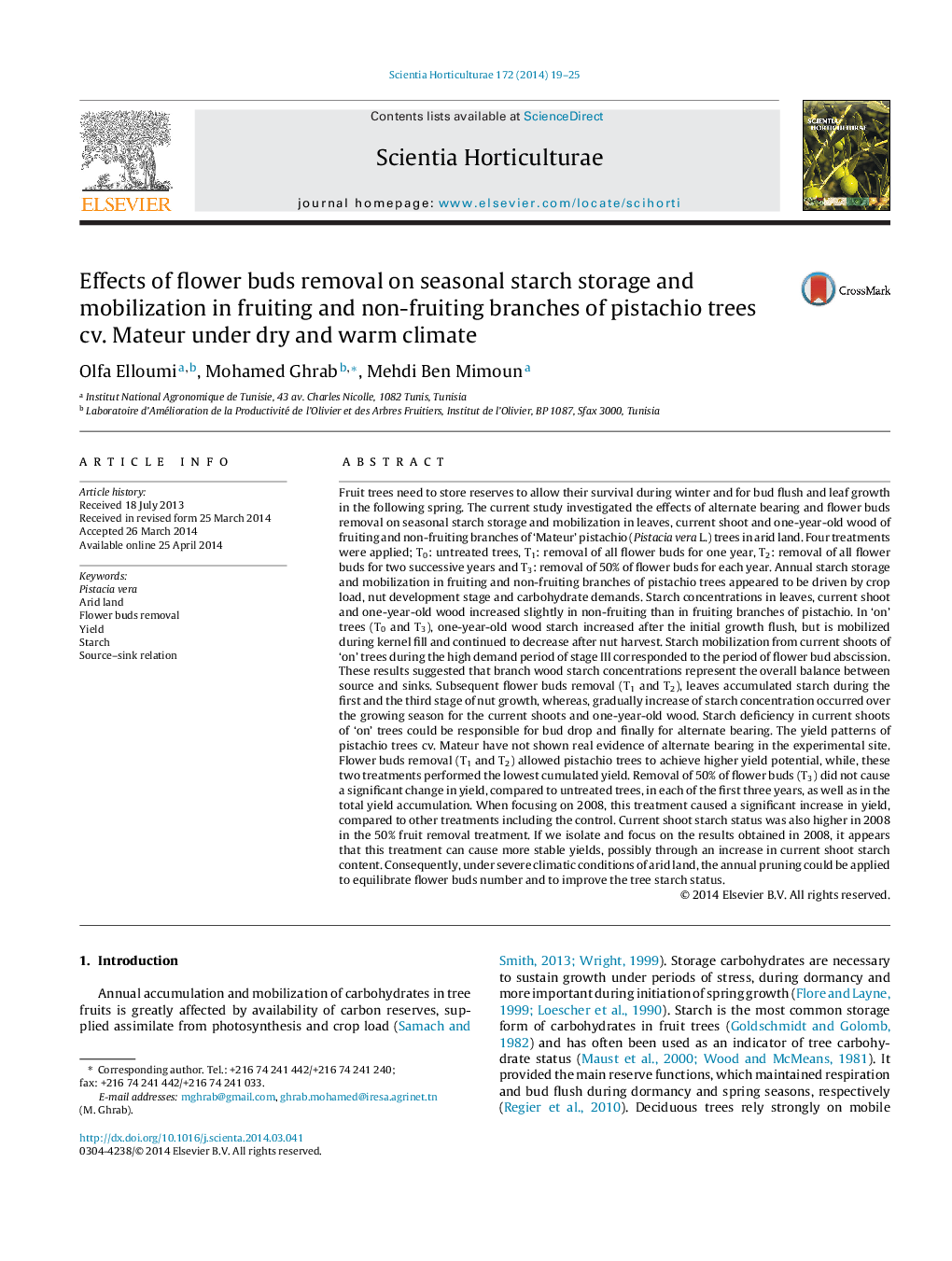| کد مقاله | کد نشریه | سال انتشار | مقاله انگلیسی | نسخه تمام متن |
|---|---|---|---|---|
| 4566808 | 1628826 | 2014 | 7 صفحه PDF | دانلود رایگان |

• Carbohydrate status of disbudded pistachio trees under dry and warm conditions.
• Annual starch storage and mobilization are driven by crop load and nut development.
• Starch deficiency in current shoots of ‘on’ trees could induce floral bud drop.
• Removal of 50% of flower bud lead to regular nut yield, increase cumulated yield.
• Pruning could improve carbohydrate status and reduced alternate bearing.
Fruit trees need to store reserves to allow their survival during winter and for bud flush and leaf growth in the following spring. The current study investigated the effects of alternate bearing and flower buds removal on seasonal starch storage and mobilization in leaves, current shoot and one-year-old wood of fruiting and non-fruiting branches of ‘Mateur’ pistachio (Pistacia vera L.) trees in arid land. Four treatments were applied; T0: untreated trees, T1: removal of all flower buds for one year, T2: removal of all flower buds for two successive years and T3: removal of 50% of flower buds for each year. Annual starch storage and mobilization in fruiting and non-fruiting branches of pistachio trees appeared to be driven by crop load, nut development stage and carbohydrate demands. Starch concentrations in leaves, current shoot and one-year-old wood increased slightly in non-fruiting than in fruiting branches of pistachio. In ‘on’ trees (T0 and T3), one-year-old wood starch increased after the initial growth flush, but is mobilized during kernel fill and continued to decrease after nut harvest. Starch mobilization from current shoots of ‘on’ trees during the high demand period of stage III corresponded to the period of flower bud abscission. These results suggested that branch wood starch concentrations represent the overall balance between source and sinks. Subsequent flower buds removal (T1 and T2), leaves accumulated starch during the first and the third stage of nut growth, whereas, gradually increase of starch concentration occurred over the growing season for the current shoots and one-year-old wood. Starch deficiency in current shoots of ‘on’ trees could be responsible for bud drop and finally for alternate bearing. The yield patterns of pistachio trees cv. Mateur have not shown real evidence of alternate bearing in the experimental site. Flower buds removal (T1 and T2) allowed pistachio trees to achieve higher yield potential, while, these two treatments performed the lowest cumulated yield. Removal of 50% of flower buds (T3) did not cause a significant change in yield, compared to untreated trees, in each of the first three years, as well as in the total yield accumulation. When focusing on 2008, this treatment caused a significant increase in yield, compared to other treatments including the control. Current shoot starch status was also higher in 2008 in the 50% fruit removal treatment. If we isolate and focus on the results obtained in 2008, it appears that this treatment can cause more stable yields, possibly through an increase in current shoot starch content. Consequently, under severe climatic conditions of arid land, the annual pruning could be applied to equilibrate flower buds number and to improve the tree starch status.
Journal: Scientia Horticulturae - Volume 172, 9 June 2014, Pages 19–25